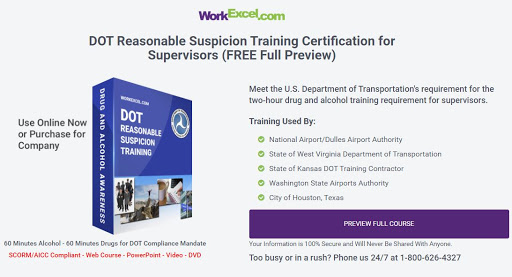Reasonable Suspicion Training: How It Helps Family Members and Dependents
Supervisors and managers receive reasonable suspicion training to help them identify the signs and symptoms of alcohol and drug abuse in the workplace. The training guides management through a reasonable suspicion documentation process.More than 26 percent of employed adults are dealing with substance abuse. When the signs of substance abuse are missed, employees are more likely to be involved in on-the-job accidents that cause injury to themselves, their coworkers, and customers.
Reasonable suspicion training is valuable and can mean the difference between an employee with a substance abuse issue getting the help they need or falling through the cracks.
Substance Abuse Outside the Workplace
Supervisors and managers are not the only ones who benefit from reasonable suspicion training. According to the U.S. Bureau of Labor Statistics, the average American worker spends 34.4 of the 168 hours in a week at work. That is less than five percent of their time at their place of employment.While some individuals battling alcohol and substance abuse issues use drugs or alcohol at work, many of them are using outside of the workplace, making it more difficult to detect the problem. That is where friends and family members become vital resources in getting substance and alcohol abusers the help they need before it is too late. Since they spend a lot of time around the person and are familiar with their normal behavior and mood, they are more likely to pick up on the subtle signs that something is wrong.
Signs and Symptoms of Substance Abuse
There are many physical and mental signs of alcohol and substance abuse. Some are more subtle than others. It is possible for individuals struggling with alcohol or drug abuse to exhibit more than one of these.
Common signs of alcohol abuse include:
- Repeated blackouts and memory lapses
- Denying drinking is occurring when confronted
- Drinking alone to avoid detection by others
- Drinking before noon
- Neglecting responsibilities like childcare and work obligations
- Driving while intoxicated
- Legal problems
- Relationship problems
- A high tolerance to alcohol before becoming inebriated
- Behavioral changes such as angry outbursts, lewd behavior, and altercations
- A decline in hygienic practices
- Changes in appetite
- Slurred speech
- Drowsiness
- Excessive excitability
- Clammy skin
- Diminished reaction time
- Impulsive behavior
- Tremors
- Coordination issues
- Intolerance to loud noises
- Sexual dysfunction
Applying Reasonable Suspicion Practices
The same reasonable suspicion practices that are effective in the workplace can help friends and families identify loved ones with alcohol and substance abuse issues and guide them to the help needed to overcome the situation.1. Stop enabling the person with the alcohol or drug abuse problem
Enabling the individual’s abuse of drugs or alcohol is never the right approach. This can include covering for them when they miss important social outings or family functions because they are hungover or suffering other ill effects of drug and alcohol misuse. Enabling is never about helping the person and has the unfortunate result of allowing the substance abuser to continue down a dangerous path. Stop making excuses for them to keep hiding the real problem.2. Observe the behaviors and signs that something is wrong
Just like on the job, it is advisable to have more than one friend or family member observe the person with the suspected drug or alcohol abuse problem when they are engaging in uncharacteristic or unsafe behaviors. Ensuring more than one person has witnessed the behavior will make it easier to approach the person with the suspected problem of getting help. It is harder to deny the behavior when more than one person has experienced it.
3. Document incidents related to the suspected misuse of drugs or alcohol
Workplace supervisors are legally required to document all reports of inappropriate or unusual behavior and other complaints from coworkers. They also must record any incidents or behaviors they observe as out of the ordinary for one of their employees. Family and friends should follow the same procedures so they have evidence of their suspicions when they confront the individual with the issue.
4. Discuss your concerns
Once several witnesses have observed and documented the behaviors, it is time to approach the person suspected of abusing drugs or alcohol. It is important to have more than one person sharing their concerns; however, do not overwhelm the individual with too many people doing the confronting. If the person feels like they are being ganged up on, they are less likely to be receptive. Part of the process of discussing concerns is the inclusion of options to help the person overcome their addiction.
5. Notify employers
If the person being approached is unwilling to admit there is an issue or receptive to receiving help, and there is a concern they may be a danger to themselves or others, it is important to notify their place of employment of the situation. Doing so may help prevent any on-the-job injuries to your loved one or their coworkers and customers. Employers also may be able to use company policy to coerce the person into treatment.
Where to Get Training
Our organization provides training for the workplace and community. Enrolling in a training program can mean the difference between a friend and a loved one getting the help they need to overcome their addiction. Give us a call toll-free at 800-626-4237 to discuss Reasonable Suspicion.


